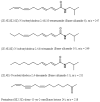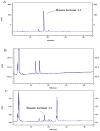Echinacea sanguinea and Echinacea pallida extracts stimulate glucuronidation and basolateral transfer of Bauer alkamides 8 and 10 and ketone 24 and inhibit P-glycoprotein transporter in Caco-2 cells
- PMID: 23408271
- PMCID: PMC3758111
- DOI: 10.1055/s-0032-1328198
Echinacea sanguinea and Echinacea pallida extracts stimulate glucuronidation and basolateral transfer of Bauer alkamides 8 and 10 and ketone 24 and inhibit P-glycoprotein transporter in Caco-2 cells
Abstract
The use of Echinacea as a medicinal herb is prominent in the United States, and many studies have assessed the effectiveness of Echinacea as an immunomodulator. We hypothesized that Bauer alkamides 8, 10, and 11 and ketone 24 were absorbed similarly either as pure compounds or from Echinacea sanguinea and Echinacea pallida ethanol extracts, and that these Echinacea extracts could inhibit the P-glycoprotein transporter in Caco-2 human intestinal epithelial cells. Using HPLC analysis, the permeation rate of Bauer alkamides by passive diffusion across Caco-2 cells corresponded with compound hydrophilicity (alkamide 8 > 10 > 11), independent of the plant extract matrix. Both Echinacea ethanol extracts stimulated apparent glucuronidation and basolateral efflux of glucuronides of alkamides 8 and 10 but not alkamide 11. Bauer ketone 24 was totally metabolized to more hydrophilic metabolites when administered as a single compound, but was also glucuronidated when present in Echinacea extracts. Bauer alkamides 8, 10, and 11 (175-230 µM) and ethanol extracts of E. sanguinea (1 mg/mL, containing ~ 90 µM total alkamides) and E. pallida (5 mg/mL, containing 285 µM total alkamides) decreased the efflux of the P-glycoprotein transporter probe calcein-AM from Caco-2 cells. These results suggest that other constituents in these Echinacea extracts facilitated the metabolism and efflux of alkamides and ketones, which might improve therapeutic benefits. Alkamides and Echinacea extracts might be useful in potentiating some chemotherapeutics, which are substrates for the P-glycoprotein transporter.
Georg Thieme Verlag KG Stuttgart · New York.
Conflict of interest statement
There are no conflicts of interest to disclose.
Figures








References
-
- Barnes J, Anderson LA, Gibbons S, Phillipson JD. Echinacea species (Echinacea angustifolia (DC.) Hell., Echinacea pallida (Nutt.) Nutt., Echinacea purpurea (L) Moench): A review of their chemistry, pharmacology and clinical properties. J Pharm Pharmacol. 2005;57:929–954. - PubMed
-
- Kligler B. Echinacea. Am Fam Physician. 2003;67:77–80. - PubMed
-
- Barnes PM, Bloom B, Nahin RL. Complementary and alternative medicine use among adults and children: United States. National Health Statistics Reports. 2007 - PubMed
-
- Borchers AT, Keen CL, Stern JS, Gershwin ME. Inflammation and Native American medicine: The role of botanicals. Am J Clin Nutr. 2000;72:339–347. - PubMed
Publication types
MeSH terms
Substances
Grants and funding
LinkOut - more resources
Full Text Sources
Other Literature Sources

